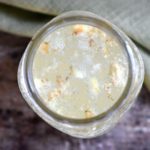Ginger Bug Starter
Ginger bug starter is easy to make and brew with. Unlike kombucha, all you need to get started is sugar and ginger root!
- Prep Time: 15 minutes
- Total Time: 15 minutes
- Yield: 3 1/4 cups 1x
- Category: Beverages
- Method: Fermented
- Cuisine: British
- Diet: Gluten Free
Ingredients
Units
Scale
- 1 large piece of fresh organic ginger (enough to make 5 Tbsp grated ginger)
- 5 Tbsp raw sugar or panela (divided)
- 3 1/4 cups of water (chlorine-free)
Instructions
- Mix 3 1/4 cup of the water with 3 Tbsp of sugar in a glass quart jar. Stir until the sugar is dissolved.
- Wash the ginger root, then grate 3 Tbsp of ginger into the quart jar. Don’t peel the ginger because the skin helps with fermentation.
- Cover with a cloth (cheesecloth or coffee filter) and secure in place with a rubber band or jar ring.
- Place the jar somewhere warm and dark to ferment (a kitchen cupboard is ideal). Give the ginger bug a good stir once or twice a day.
- After 3 to 7 days it should start to bubble. Once it’s started to bubble, feed it 1 Tbsp of sugar and 1 Tbsp of grated ginger each of the next two days.
- When it is really bubbly you are ready to make ginger beer or ginger bug sodas. See the section above for information on how to maintain your ginger bug starter.
Notes
- Fresh turmeric root can be used instead of ginger or in combination with ginger. Perfect for making a bright yellow turmeric soda.
- The ginger bug needs to feed on sucrose, so don’t use alternative sweeteners. Coconut sugar
is fine, but honey and maple syrup are not.
- Expect a bit of scum to form on the top. These will be strands of yeast that are eating the sugar and ginger. Watch out for mold or a bad smell, which means it’s gone off.
- The amount of time it takes to catch a ginger bug depends on a lot of things: temperature, the strains of wild yeasts in your home, and how fresh the ginger is. Don’t start feeding your starter until it’s started bubbling, or you’ll end up adding too much sugar, resulting in a thick, syrupy starter.
- Certain strains of bacteria can cause ginger bug (and other ferments) to end up thick and syrupy. This will often resolve as the fermentation continues and acidifies. If you’re concerned, add a bit of fresh turmeric root to the ginger bug. Turmeric and ginger have the same culture, but I’ve found that fresh turmeric is just a bit better at promoting the right cultures. I suspect it’s because fresh turmeric doesn’t have the same industrial process behind it and is more likely to still have the natural culture on its skin.
Find it online: https://www.fermentingforfoodies.com/catching-ginger-bug/
